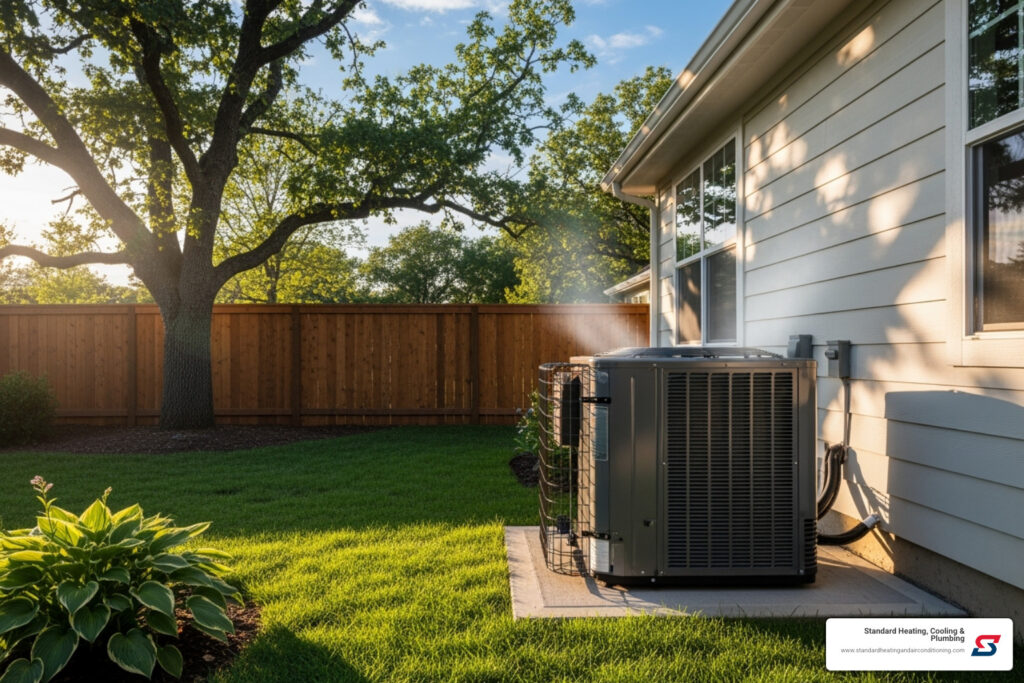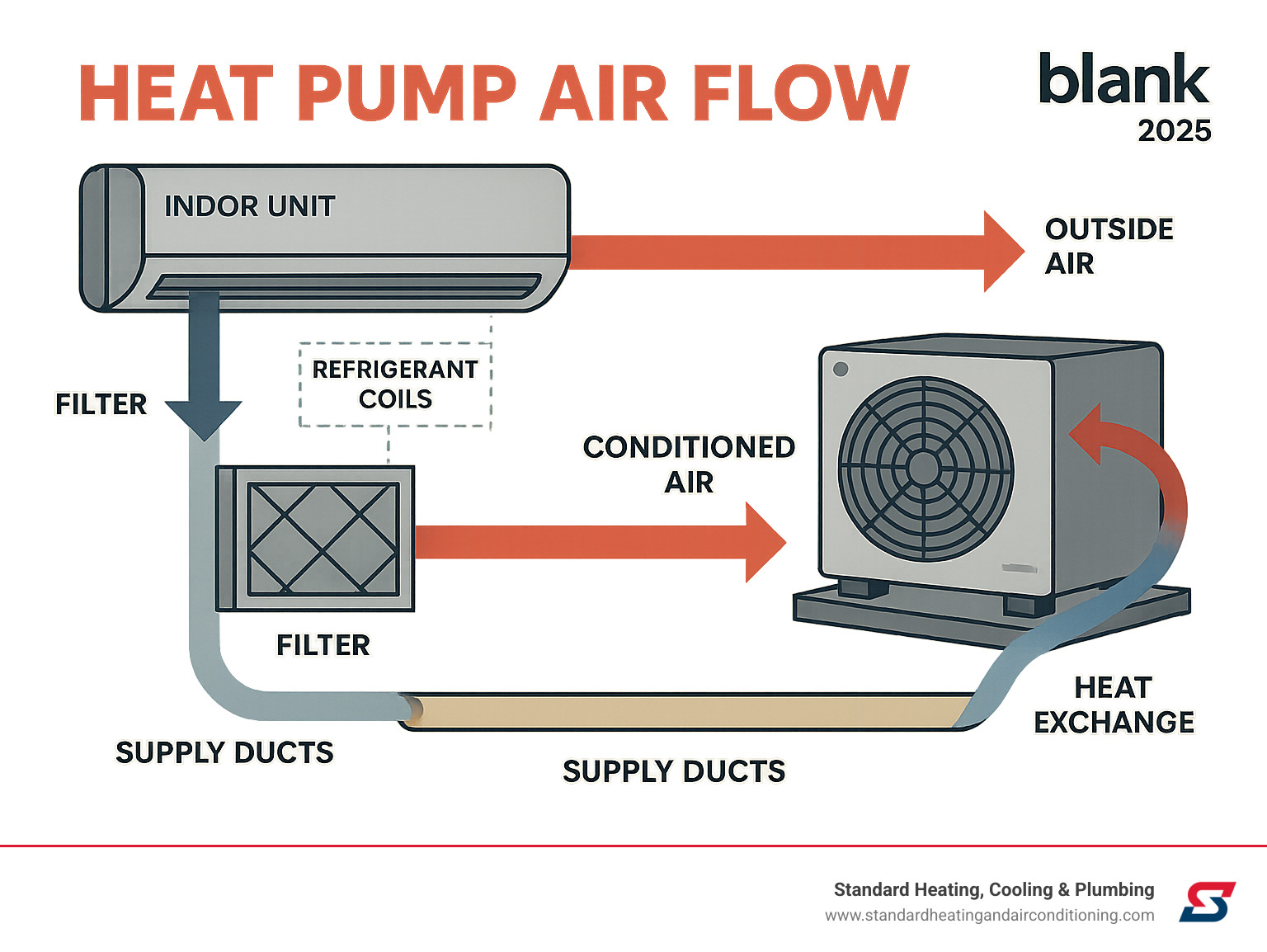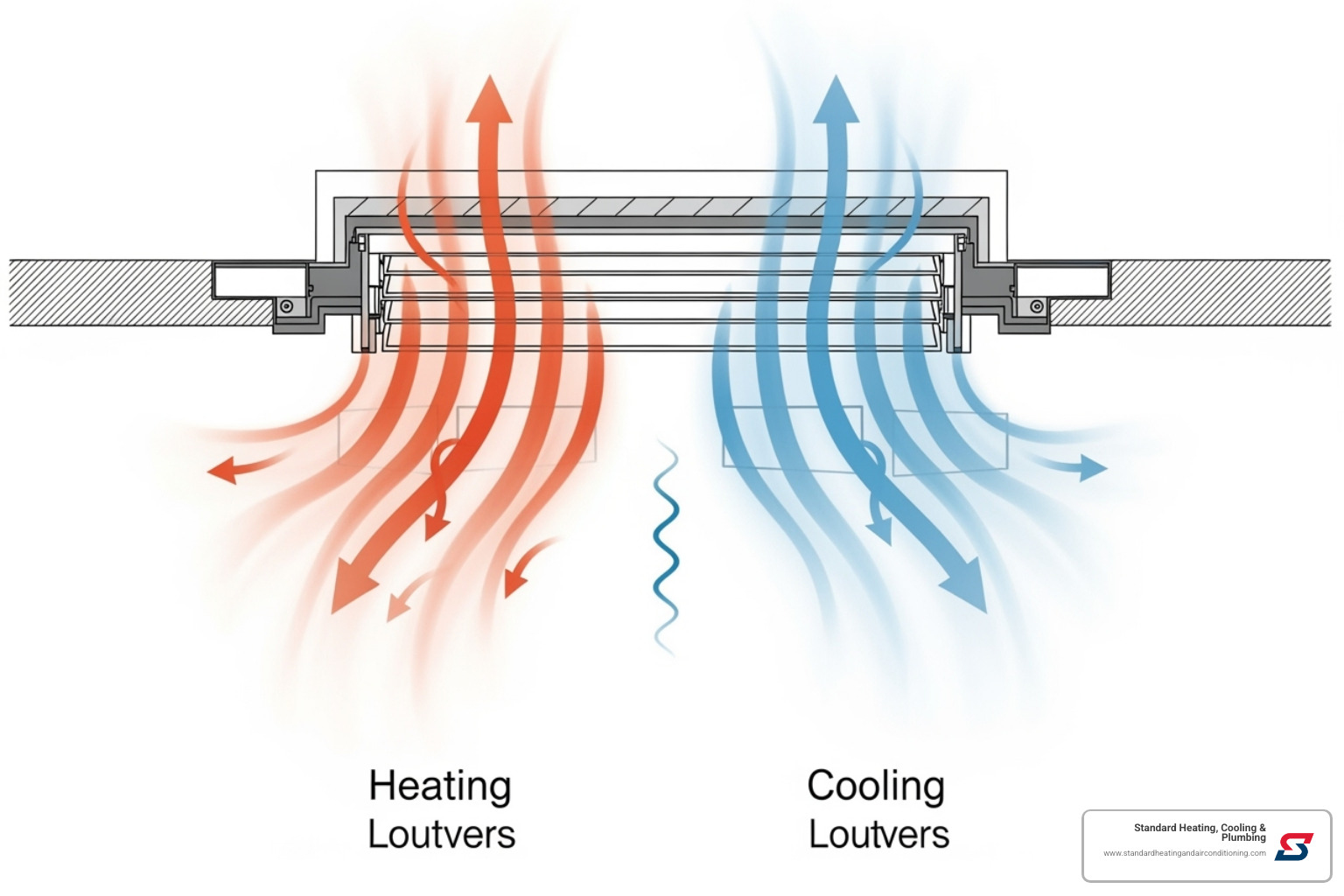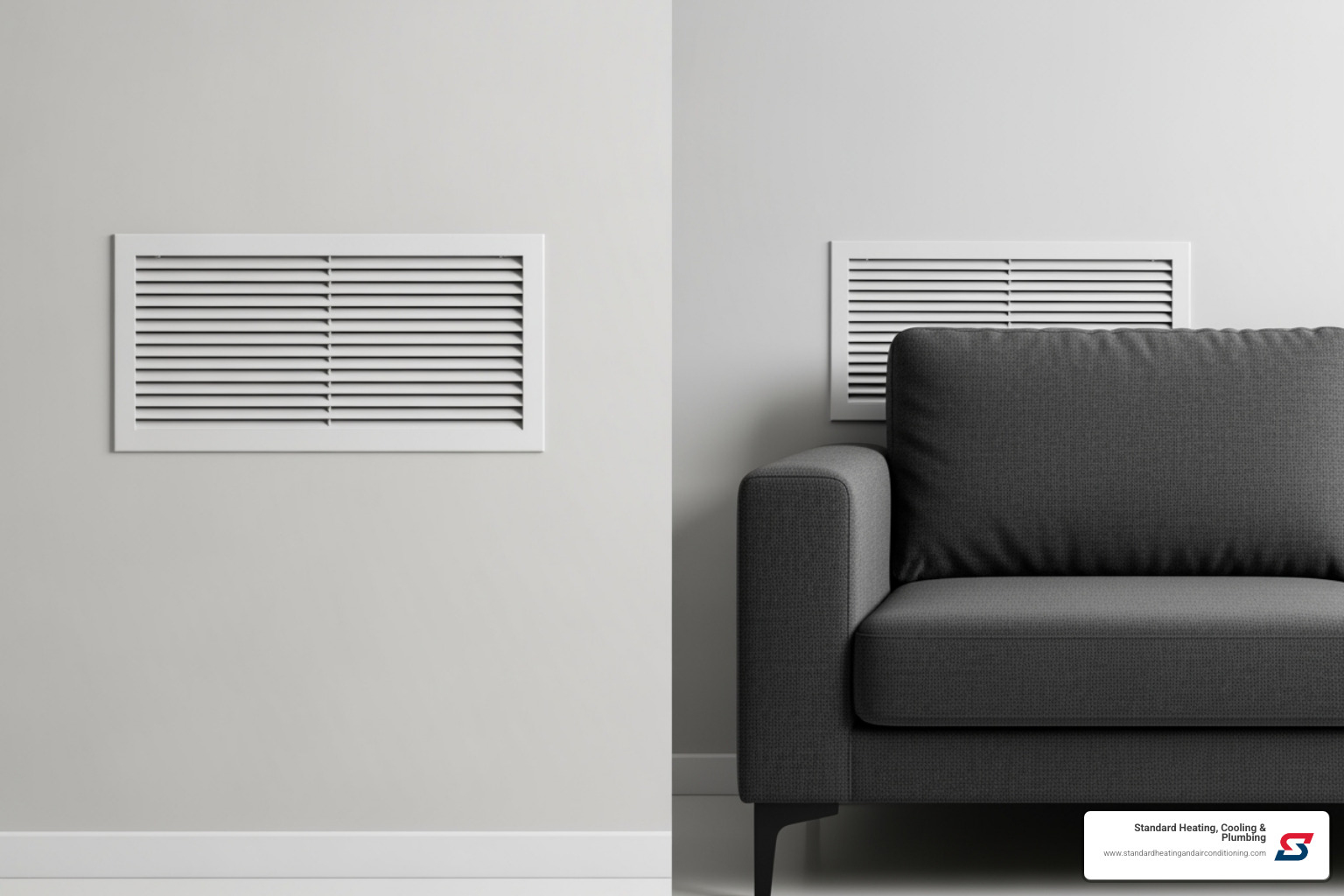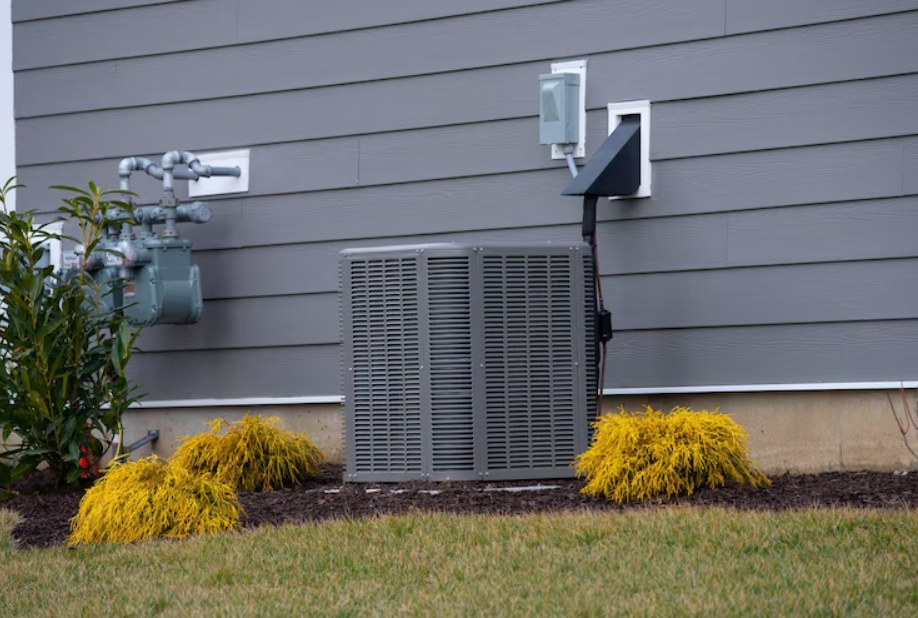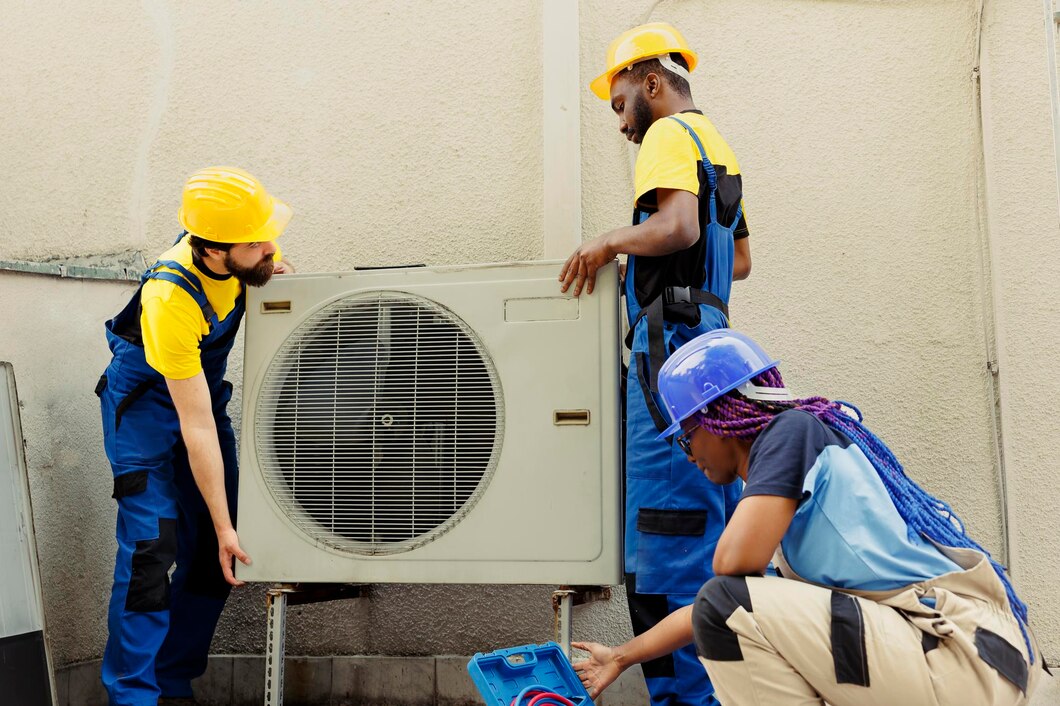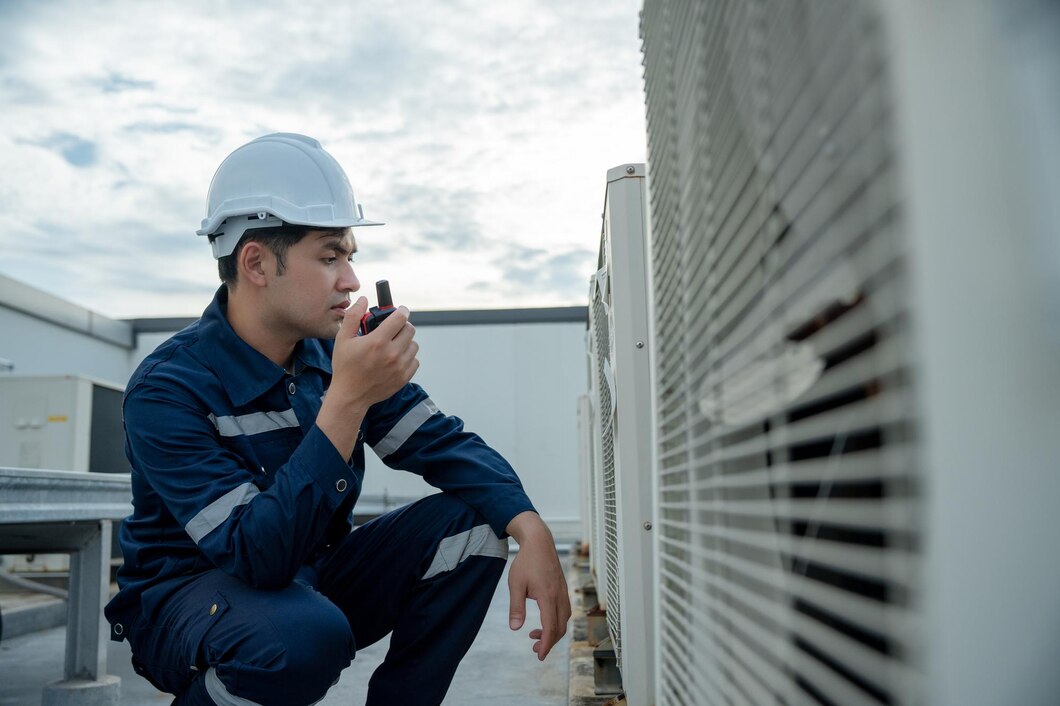Why Heat Pump Air Flow Matters More Than You Think
Heat pump air flow is the foundation of your system’s performance, comfort, and efficiency. When air moves properly through your heat pump, it transfers heat effectively, maintains consistent temperatures, and keeps your energy bills low.
Key Heat Pump Airflow Facts:
- Ideal flow rate: 400 cubic feet per minute (CFM) per ton of capacity
- Minimum safe flow: 350 CFM per ton (below this, efficiency drops)
- Supply air temperature: 90-110°F (cooler than furnace air at 125°F)
- Filter impact: Clean filters can improve airflow by up to 30%
Many Birmingham homeowners don’t realize that their heat pump’s airflow directly affects everything from monthly utility costs to indoor comfort. Poor airflow causes your system to work harder, cycle more frequently, and struggle to reach your desired temperature.
The good news? Most airflow issues have simple solutions. Understanding how air moves through your heat pump – and what can go wrong – helps you maintain peak performance and avoid costly repairs.
Whether you’re dealing with uneven temperatures, higher energy bills, or that “cold blow” sensation from your vents, the answer often comes down to airflow optimization.
The Science of Heat Pump Airflow: What Homeowners Should Know
Your heat pump is like the lungs of your home – constantly breathing in and out to keep you comfortable. But instead of oxygen, it’s moving air that carries warmth in winter and coolness in summer. Understanding how this process works can help you get the most from your system.
Heat pump air flow is all about moving the right amount of air at the right speed through your home. When air passes over your heat pump’s coils, it either picks up heat or drops it off, depending on the season. Then your blower motor pushes this conditioned air through your supply ducts to every room.
The air eventually makes its way back through return ducts to start the cycle all over again. It’s a continuous loop that keeps your home comfortable – when everything’s working properly.
But here’s where things get interesting. Your system has to overcome something called static pressure – basically, the resistance air faces as it travels through filters, ducts, and coils. Think of it like trying to breathe through a straw versus breathing normally. Poor ductwork design with ducts that are too small, too long, or have too many sharp turns creates extra resistance that makes your blower work harder.
Understanding these Basics of Airflow helps explain why proper installation and maintenance matter so much for your comfort and energy bills.
The Ideal Heat Pump Air Flow Rate (CFM)
Here’s a number worth remembering: 400 CFM per ton. That’s how much airflow your heat pump needs to work at peak efficiency. CFM stands for Cubic Feet per Minute – basically how much air your system moves every minute.
So if you have a 3-ton heat pump, it should move about 1,200 CFM of air. A 2-ton system needs around 800 CFM. This might sound technical, but it’s actually pretty important for your wallet and comfort.
When airflow drops below 350 CFM per ton, your system starts struggling. The heat transfer across the coils becomes less efficient, which means your heat pump has to work longer and harder to reach your thermostat setting.
This creates a domino effect of problems. Your energy bills go up because the system runs more often. Hot and cold spots appear throughout your home because conditioned air isn’t circulating properly. Your equipment wears out faster because the blower motor and other components are under constant strain.
The good news? Proper system sizing and regular maintenance can keep your airflow right where it needs to be. Your blower motor needs to be calibrated correctly, and your ductwork should be designed to handle your system’s capacity without creating excessive resistance.
If you’re noticing uneven temperatures or higher energy bills, airflow issues might be the culprit. Professional Heat Pump Maintenance & Repair can identify and fix these problems before they get expensive.
Why Heat Pump Air Feels Different Than a Furnace
If you’ve recently switched from a gas furnace to a heat pump, you might be wondering why the air from your vents feels different. Don’t worry – your new system isn’t broken. It’s just working smarter, not hotter.
A gas furnace creates heat by burning fuel, which can heat air to around 125°F by the time it reaches your vents. That’s hot enough to feel like a warm blast when you walk by a register.
Heat pumps work differently. Instead of creating heat, they transfer heat from outside air into your home. This process produces supply air that’s typically between 90°F and 110°F – definitely warmer than your body temperature, but noticeably cooler than furnace air.
This temperature difference leads to what some homeowners call the “cold blow” sensation. The air doesn’t feel as hot, so it might seem like your system isn’t working hard enough.
But here’s the clever part: heat pumps compensate by moving much more air than a furnace. While the air temperature is lower, the total amount of heat delivered depends on both temperature and volume. Your heat pump delivers consistent, gentle warmth instead of short blasts of super-hot air.
This approach actually creates better overall comfort. You get more even temperatures throughout your home without the sudden temperature swings that come with furnace cycling. No more walking from a toasty spot near a vent to a chilly corner across the room.
The continuous, higher-volume airflow also means better air filtration and humidity control. So while the air might feel different, most homeowners find heat pump comfort superior once they get used to it.
Still concerned about that cooler air feeling? Check out this detailed explanation of ‘Cold Blow’ from Heat Pump Supply Air – GreenBuildingAdvisor for more insights into this perfectly normal heat pump behavior.
Optimizing Your Airflow for Maximum Comfort and Efficiency
Getting the most from your heat pump air flow isn’t rocket science – it’s about understanding how air naturally behaves and working with it, not against it. Think of it like steering a boat with the current instead of fighting upstream. A few smart adjustments to how and when your air moves can transform your comfort while keeping those energy bills in check.
The beauty of modern heat pumps is that they give you control over both the direction and speed of airflow. But here’s what many Birmingham homeowners don’t realize: the “set it and forget it” approach might not be giving you the best results. Different seasons call for different strategies.
Directing Airflow: Best Practices for Heating vs. Cooling
Here’s where physics becomes your friend. Warm air rises, cool air sinks – and your heat pump’s airflow direction should work with these natural tendencies, not against them.
During heating mode, you want to direct that warm air downward. Yes, it might seem backwards at first, but there’s smart reasoning behind it. When warm air hits the floor, it naturally rises and circulates throughout the room, creating even temperatures from floor to ceiling. This prevents those annoying cold spots near the floor that make your feet chilly even when the thermostat says it’s warm.
Point your vanes toward the farthest corner of the room, away from where people typically sit. This gives the warm air maximum space to spread before it naturally convects upward. Natural convection does the rest of the work for you, creating a gentle circulation pattern that feels comfortable rather than drafty.
Cooling mode flips the script entirely. Now you want to direct that cool air upward, and it’s perfectly fine to aim it toward people in the room. Cool air naturally sinks, so shooting it up gives it room to fall and spread evenly. Plus, that gentle breeze feels refreshing when you’re trying to cool down.
This upward direction also helps with avoiding drafts in seating areas while still providing effective cooling. The cool air cascades down naturally, creating a pleasant circulation pattern without making anyone feel like they’re sitting in a wind tunnel.
Fan Speed Settings: Auto vs. Manual
Your heat pump’s fan speed might seem like a minor detail, but it’s actually one of the most important settings for both comfort and efficiency. Most homeowners set it once and never think about it again – but understanding your options can make a real difference.
The ‘Auto Fan’ setting is usually your best friend. Think of it as cruise control for your comfort system. The fan automatically speeds up when your heat pump is working hard to reach your desired temperature, then slows down to maintain that comfort level with continuous circulation. This keeps air moving just enough to prevent stagnant pockets while avoiding the energy waste of running full blast all the time.
Auto fan also helps with humidity control. That gentle, consistent air movement helps your heat pump remove moisture more effectively during cooling season, making your home feel more comfortable even at higher temperatures.
Manual adjustments have their place too, especially in larger homes or open floor plans. If you notice that certain areas aren’t getting enough conditioned air, bumping the fan speed up a notch can help push air into those harder-to-reach spots. Just remember that higher fan speeds mean more energy use and potentially more noise.
Some homeowners worry about running their fan continuously, but modern heat pumps are designed for this kind of operation. The key is finding that sweet spot where you get good air circulation without overdoing it.
For more detailed guidance on getting the most from your system settings, check out the official recommendations for Operating and maintaining your heat pump.
Common Roadblocks to Proper Airflow and How to Fix Them
Even with the most amazing heat pump system, sometimes the air just doesn’t seem to flow right. It’s like your system is trying its best, but something’s holding it back. Ignoring these little hiccups can lead to less comfort, higher energy bills, and even unnecessary wear and tear on your trusty unit. We’ve certainly seen it all, from the super obvious to the sneaky issues that are easy to miss!
The good news? Many of these roadblocks have pretty straightforward fixes. Just knowing what to look for is the first step toward a happy, efficient heat pump. For a broader look at potential issues your system might face, check out our insights on Common Heat Pump Problems.
Troubleshooting Common Heat Pump Air Flow Issues
Think of these as your heat pump’s “breathing issues.” A few quick checks can help you figure out if your system is struggling to take a deep breath and push that conditioned air where it needs to go.
First up, the most frequent culprit: dirty air filters. This is almost always the number one reason for poor heat pump air flow. A clogged filter acts like a thick blanket over your system’s lungs, forcing it to work much harder to pull air through. We recommend giving your air filter a peek every month, especially when you’re using your heat pump a lot, and cleaning or replacing it as needed. It’s a simple step that makes a huge difference!
Next, let’s talk about blocked registers or vents. Take a quick tour around your home. Are your supply and return vents clear of everything? Sometimes, furniture, cozy rugs, long drapes, or even a pile of toys can accidentally block the air’s path. Make sure all your registers are wide open and have plenty of room to breathe. For really efficient air circulation, most rooms need both a supply vent (where the conditioned air comes out) and a return vent (where the air goes back to the system).
Don’t forget about your outdoor unit either! It needs its space too. An obstructed outdoor unit can’t properly exchange heat with the outside air, which hurts your system’s overall efficiency. Make sure it’s clear of leaves, grass clippings, snow, or anything else that might have accumulated. If you have bushes or plants growing nearby, give them a trim so there’s at least two feet of clear space around the unit.
You might not think about it, but closed interior doors can also mess with your airflow. While it seems logical to close doors for privacy or to contain heat/cool air, it can actually create pressure imbalances, especially if a room doesn’t have its own dedicated return vent. This can make temperatures uneven throughout your home. In frequently closed rooms, consider adding grilles to the doors or walls to help air circulate more freely.
Finally, we have leaky ductwork. Imagine trying to fill a balloon that has a bunch of tiny holes – a lot of air escapes before it gets where it’s supposed to go! The same happens with your ducts, especially if they run through unconditioned spaces like your attic or crawl space. Significant amounts of conditioned air can escape, leading to reduced heat pump air flow and wasted energy. While finding every leak often requires a professional, you might spot obvious tears or disconnections. Duct sealing is a fantastic way to improve airflow and cut down on energy waste.
If you’ve gone through these checks and your heat pump still isn’t breathing easy, don’t worry! It might be time for a professional eye. Our team at Standard Heating, Cooling & Plumbing can perform a thorough inspection and get to the bottom of any underlying problems.
The Critical Role of Air Filters and Coils
We simply can’t say it enough: your air filter is like the superhero cape for your heat pump! It’s the absolute first line of defense against dirt and debris, and it’s super critical for maintaining proper heat pump air flow. A clean filter lets air zoom through freely, protecting all those sensitive parts inside your system, especially the evaporator coil.
When it comes to Filter MERV Rating & Airflow Restriction, think of MERV (Minimum Efficiency Reporting Value) as how good a filter is at catching tiny particles. Higher MERV ratings mean better filtration, but sometimes, they can also make it harder for air to pass through. For most homes, a MERV 8-11 filter is a perfect balance – it cleans the air well without making your heat pump work too hard. If you’re using a super high MERV 13+ filter and notice your airflow is struggling, it might be too restrictive for your system. In those cases, a slightly lower MERV rating might actually improve your overall efficiency and heat pump air flow. Another trick? Upgrading to a larger filter size, like going from a 1-inch to a 4-inch filter, gives the air more surface area to pass through, boosting airflow.
The amazing part? Just by cleaning filters regularly, you can improve the heat pump air flow in your home by as much as 30%! For disposable filters, just swap them out according to the manufacturer’s directions, or even more often if you have furry friends, allergies, or a lot of dust. If you have a reusable filter, a regular cleaning routine will keep it in top shape.
Even with the best filter routine, your evaporator coil (that indoor coil where all the magic of heat absorption or release happens) can still get a bit grubby over time. A dirty coil is like a permanent, hidden filter that severely restricts heat pump air flow and stops your system from transferring heat effectively. This forces your heat pump to work harder, gulp down more energy, and can even shorten its lifespan. That’s why professional evaporator coil cleaning is a vital part of routine heat pump maintenance.
Regular TLC, including consistent filter changes and professional coil cleaning, is absolutely essential for ensuring fantastic heat pump air flow. For more simple tips on keeping your system happy and healthy, check out our Heat Pump Maintenance Tips.
The Payoff: Key Benefits of Optimized Airflow
When you take the time to optimize your heat pump air flow, you’re not just tweaking a few settings – you’re open uping your system’s full potential. Think of it like tuning up a car engine. The difference between good airflow and great airflow can be felt in every room of your home and seen on every utility bill.
The benefits go far beyond just staying comfortable. Proper airflow creates a ripple effect that touches everything from your monthly budget to your family’s health and well-being.
How Proper Airflow Management Leads to Energy Savings
Here’s where optimized heat pump air flow really pays dividends. When air moves efficiently through your system, your heat pump operates like the well-oiled machine it was designed to be.
Reduced system strain is the first domino to fall. Your blower motor doesn’t have to fight against clogged filters or blocked vents. Your compressor doesn’t have to work overtime trying to condition air that’s barely moving. Everything runs smoother and uses less electricity.
Your system also achieves setpoints faster when airflow is optimized. Instead of struggling to push conditioned air through your home, your heat pump can quickly and evenly distribute comfortable temperatures. This means shorter run cycles and less energy consumed overall.
The result? Lower utility bills that you’ll notice month after month. Heat pumps already deliver impressive efficiency – often producing two to four times more heat energy than the electrical energy they consume. But that efficiency only matters if your system can actually deliver that conditioned air where it needs to go.
Peak efficiency isn’t just a marketing promise when your airflow is dialed in correctly. That ENERGY STAR® label on your unit represents real savings potential, but only if your system can breathe freely and distribute air effectively throughout your home.
Enhancing Home Comfort and Air Quality
The comfort improvements from proper airflow are often the first thing Birmingham homeowners notice. Gone are the days of eliminating hot and cold spots that make some rooms feel like saunas while others remain chilly. When air flows correctly, conditioned air reaches every corner of your home evenly.
Better dehumidification becomes possible when air moves at the right speed over your heat pump’s coils. Too fast, and moisture doesn’t have time to condense out. Too slow, and the system can’t process enough air to make a difference. Get it just right, and your home feels more comfortable even at higher thermostat settings.
The continuous air filtration that comes with optimized airflow means cleaner air for your family. When your system can move air efficiently, it’s constantly pulling indoor air through filters, capturing dust, pollen, and other particles that would otherwise circulate freely.
This leads to reduced allergens and dust throughout your home – a blessing for anyone who suffers from allergies or respiratory issues. The constant, gentle circulation creates an environment where airborne particles get filtered out rather than settling on surfaces or floating around your living spaces.
Your heat pump becomes more than just a heating and cooling system. It transforms into a comprehensive comfort solution that actively improves the air your family breathes every day. Learn more about these benefits in our guide on How Heat Pumps Improve Home Comfort.
Conclusion
Phew! We’ve taken quite a journey through the fascinating world of heat pump air flow, haven’t we? From understanding the science behind CFM and supply air temperatures to finding practical tips for optimizing your system, it’s clear just how vital proper airflow is. We’ve seen how simple adjustments, like directing air up for cooling and down for heating, can boost your comfort. And we’ve uncovered the sneaky culprits – like dirty filters or blocked vents – that can sabotage even the most efficient heat pump.
The big takeaway? Heat pump air flow isn’t just some technical detail; it’s truly the heart of a happy, efficient, and long-lasting heat pump system. When air moves freely and correctly, your home stays consistently comfortable, your energy bills stay low, and the air you breathe indoors is cleaner and healthier for your whole family.
While many airflow hiccups can be smoothed out with a few simple homeowner checks and routine maintenance, sometimes the problem runs a little deeper. That’s where we come in! At Standard Heating, Cooling & Plumbing, we’ve been a family-owned business for 85 years, proudly serving our neighbors in Birmingham, AL, and surrounding communities like Alabaster, Chelsea, and Gardendale. Our mission is simple: to deliver high-quality, reliable, and affordable comfort solutions with a smile. Our team of certified technicians isn’t just experienced; they’re equipped with advanced technology to diagnose and expertly resolve even the trickiest heat pump airflow challenges.
Don’t let poor airflow leave you feeling uncomfortable or cause your energy bills to creep up. If your heat pump isn’t breathing easy, or if you just want to ensure it’s performing at its best, we’re here to help. For expert heat pump repair, installation, or a thorough maintenance check, reach out to us today.
Contact us for expert heat pump repair and installation in Alabaster, AL

